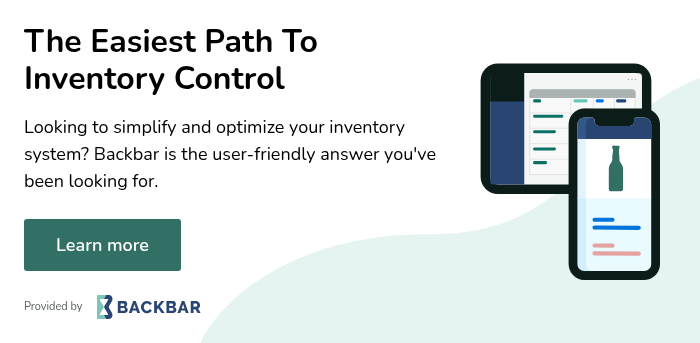Pricing drinks can be a tricky part of the bar business, but it doesn’t have to be. Pricing your drinks properly ensures that you are able to sustain your bar long-term, and it shows other bar professionals that you know what you’re doing. Whether you’re just getting into the bar game, or you’re a seasoned pro, it’s always a good idea to reassess your drink prices to see if they need to be adjusted. Here’s how.
Figure Your Liquor Cost
Your “liquor cost” is how much it costs you to purchase each ounce of your alcohol.
To determine your liquor cost properly, you need to follow the liquor cost formula:
Bottle purchase price ÷ ounces in a bottle = cost per ounce
This will help you determine how many ounces you have in each bottle:
A liter is 33.8 ounces
A 750 is 25.4 ounces
Therefore, if you purchase a 750 of Grey Goose for $20 (you got a good deal!), you would follow this formula:
$20 (bottle purchase price) ÷ 25.4 ounces (ounces in a 750mL bottle) = 79 cents per ounce
But, of course, it doesn’t stop there.
Since drinks usually contain about two ounces of alcohol, you’ll need to double your final amount (or determine how many ounces you typically pour) to figure out your total liquor cost per drink. Your liquor cost will change with each bottle you serve.
In the previous example, one ounce of Grey Goose cost you 79 cents, so the 2 ounce drink you poured made your total liquor costs for that drink $1.58.
Figure Your Pour Cost
You’ve figured your liquor cost, but now you need to figure out your profit/markup, which is known as your “pour cost”. This is where the drink charge becomes tricky.
Why? Because your pour cost is entirely subjective.
What percentage do you want to make off of a drink? That is entirely dependent on the costs you need to charge to cover your overhead.
If you’re in a downtown area, your rent and advertising needs are steeper, and you’ll need a lower pour cost to cover your overhead. If you’re out in the country, you probably don’t have to pay as much to keep yourself in business, and you can work with a higher pour cost.
Wait—did I just say that higher overheard means a lower pour cost and lower overhead means a higher pour cost? What gives?
Remember: liquor cost is what YOU pay for the drink, therefore a higher pour cost means that a higher percentage of your per-drink income is coming out of your pocket.
Conversely, a lower pour cost means that a lower percentage of your per-drink income is coming out of your pocket, and that therefore you make a higher profit.
Go ahead and read it again. I’ll wait.
Okay, now that you’re starting to have an idea about how to consider your costs, you’ll want to know what a standard rate is for the pour cost. The bad news is that there is no “standard” rate, but if your bar is awesome enough to get a 15% pour cost, you’re doing really, really well.
If you want to charge less, you could go up to a 25% pour cost, but that means that your guests are only paying for 75% of the drinks they receive. If you aim your pour cost to fall in the 18%-24% range, you’re doing well. Whatever you choose, figure your pour cost and then stick to it.
To figure this math, you use this formula:
Liquor cost ÷ pour cost in decimals = drink charge
For example:
If the Grey Goose drink that you poured in the previous example has a 15% pour cost…
$1.58 (liquor cost) ÷ 0.15 (pour cost) = $10.53 drink charge
If the Grey Goose has a 24% pour cost…
$1.58 (liquor cost) ÷ 0.24 (pour cost) = $6.58 drink charge
That is one heck of a difference!
Check out this blog post to learn more about how to lower liquor costs.
Don’t Forget the Garnish!
Many bar owners get so caught up in their liquor costs and pour costs, that they forget how much their mixers and garnishes cost. Make it easy on yourself and charge a flat 50 cents extra (past the drink cost) for every drink that requires mixers and/or garnishes.
For example, if you’re adding lime and soda to make a Vodka Gimlet, and you’re sticking with that 15% pour cost, the drink charge is now $11.03.
Round to the Nearest Quarter
Counting out pennies at a bar is just too hard, and prying sticky nickels off of the floor behind the bar is a nightmare. Don’t deal with the small change, round everything UP to the nearest quarter.
Now that Grey Goose Gimlet costs your guest a grand total of $11.25.
A Closing Word
I’m sorry to tell you this, but no matter how high your pour cost is (AKA how cheap your drinks are), there will be people who hate you and think you’re charging too much money. The thing to remember is that what you charge is a deeply personal choice, and since your charges determine the longevity and success of your bar, you should make sure to stick to your guns on your pricing.
Yes, people will complain, yes, some people may decide that they don’t want to buy drinks from you. Truly though, your bar has taken sacrifices from you, it has taken countless hours, plus your heart and soul to keep it afloat—and I think that you should be paid fairly for all your hard work.
Now pull out your calculator and figure those prices!



